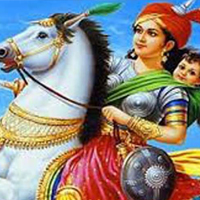Rani of Jhansi
Lakshmibai, the Rani of Jhansi, was an Indian queen, the Maharani consort of the Maratha princely state of Jhansi from 1843 to 1853 as the wife of Maharaja Gangadhar Rao. She was one of the leading figures of the Indian Rebellion of 1857 and became a symbol of resistance to the British Raj for Indian nationalists.
Rani Lakshmibai was born in the town of Varanasi into a Marathi Karhade Brahmin family.[7] She was named Manikarnika Tambe and was nicknamed Manu.[8] Her father was Moropant Tambe[9] and her mother Bhagirathi Sapre (Bhagirathi Bai). Her parents came from Maharashtra.[10] Her mother died when she was four years old. Her father was the Commander of the war of Kalyanpranth. Her father worked for Peshwa Baji Rao II of Bithoor district. She was educated at home and was taught to read and write, and was more independent in her childhood than others of her age; her studies included shooting, horsemanship, fencing[12][13] and mallakhamba with her childhood friends Nana Sahib and Tatya Tope. Rani Lakshmibai contrasted many of the patriarchal cultural expectations for women in India’s society at this time. Lakshmi Bai had an unusual upbringing for a Brahman girl. Growing up with the boys in the peshwa’s court, she was trained in martial arts and became proficient in sword fighting and riding. She married the maharaja of Jhansi, Gangadhar Rao. In September 1851, she gave birth to a boy, later named Damodar Rao, who died four months after birth. The Maharaja adopted a child called Anand Rao, the son of Gangadhar Rao’s cousin, who was renamed Damodar Rao, on the day before the Maharaja died. The adoption was in the presence of the British political officer who was given a letter from the Maharaja instructing that the child be treated with respect and that the government of Jhansi should be given to his widow for her lifetime. She was widowed without bearing a surviving heir to the throne. Following established Hindu tradition, just before his death the maharaja adopted a boy as his heir. Lord Dalhousie, the British governor-general of India, refused to recognize the adopted heir and annexed Jhansi in accordance with the doctrine of lapse. An agent of the East India Company was posted in the small kingdom to look after administrative matters.
The 22-year-old queen refused to cede Jhansi to the British. Shortly after the beginning of the mutiny in 1857, which broke out in Meerut, Lakshmi Bai was proclaimed the regent of Jhansi, and she ruled on behalf of the minor heir. Joining the uprising against the British, she rapidly organized her troops and assumed charge of the rebels in the Bundelkhand region. Mutineers in the neighbouring areas headed toward Jhansi to offer her support.
Under Gen. Hugh Rose, the East India Company’s forces had begun their counteroffensive in Bundelkhand by January 1858. Advancing from Mhow, Rose captured Saugor (now Sagar) in February and then turned toward Jhansi in March. The company’s forces surrounded the fort of Jhansi, and a fierce battle raged. Offering stiff resistance to the invading forces, Lakshmi Bai did not surrender even after her troops were overwhelmed and the rescuing army of Tantia Tope, another rebel leader, was defeated at the Battle of Betwa. Lakshmi Bai managed to escape from the fort with a small force of palace guards and headed eastward, where other rebels joined her.
Tantia Tope and Lakshmi Bai then mounted a successful assault on the city-fortress of Gwalior. The treasury and the arsenal were seized, and Nana Sahib, a prominent leader, was proclaimed as the peshwa (ruler). After taking Gwalior, Lakshmi Bai marched east to Morar to confront a British counterattack led by Rose. On 17 June in Kotah-ki-Serai near the Phool Bagh of Gwalior, a squadron of the 8th (King’s Royal Irish) Hussars, under Captain Heneage, fought the large Indian force commanded by Rani Lakshmibai, who was trying to leave the area. The 8th Hussars charged into the Indian force, slaughtering 5,000 Indian soldiers, including any Indian “over the age of 16”.[41] They took two guns and continued the charge right through the Phool Bagh encampment. In this engagement, according to an eyewitness account, Rani Lakshmibai put on a sowar’s uniform and attacked one of the hussars; she was unhorsed and also wounded, probably by his sabre. Shortly afterwards, as she sat bleeding by the roadside, she recognised the soldier and fired at him with a pistol, whereupon he “dispatched the young lady with his carbine”.[42][43] According to another tradition Rani Lakshmibai, the Queen of Jhansi, dressed as a cavalry leader, was badly wounded; not wishing the British to capture her body, she told a hermit to burn it. The British captured the city of Gwalior after three days. In the British report of this battle, Hugh Rose commented that Rani Lakshmibai is “personable, clever and beautiful” and she is “the most dangerous of all Indian leaders”.[44][45] Rose reported that she had been buried “with great ceremony under a tamarind tree under the Rock of Gwalior, where I saw her bones and ashes

Rani of Jhansi
Date of Birth: 19 Nov 1828
Birth Place: Varanasi
Proffession: Indian queen
Nationality: Indian
Death: 18 June 1858, Gwalior


